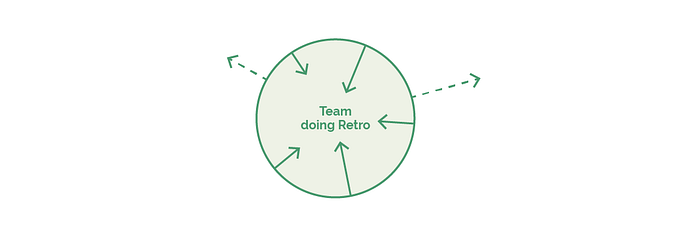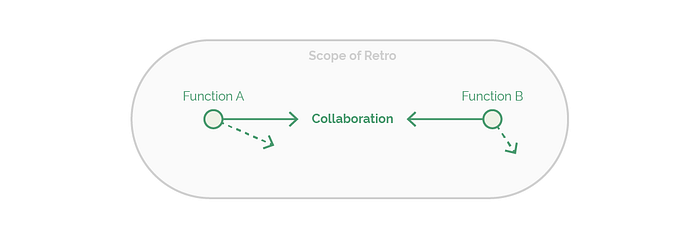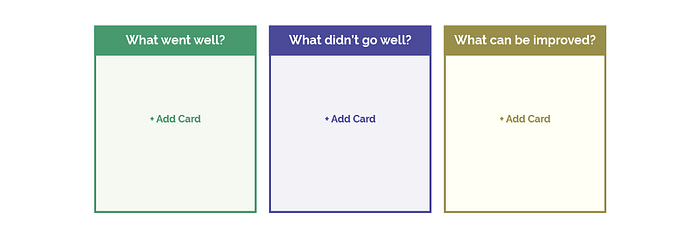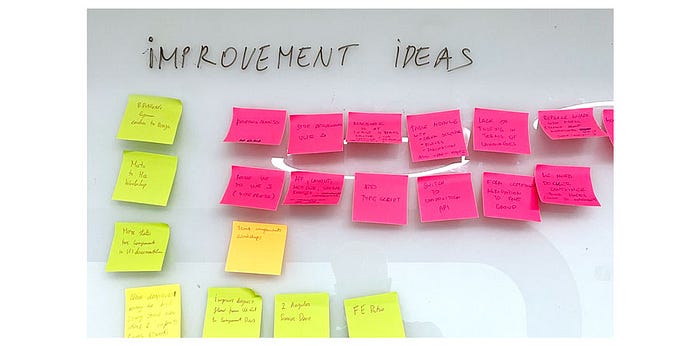

Cross-Functional Retrospectives
source link: https://uxplanet.org/cross-functional-retrospectives-fef5d59d0f25
Go to the source link to view the article. You can view the picture content, updated content and better typesetting reading experience. If the link is broken, please click the button below to view the snapshot at that time.
Cross-Functional Retrospectives
A Simple Way to Manage Organisational Complexity

Retrospectives
We are all familiar with Retrospectives. They do come in many shapes (from what went well to a sailboat and beyond). Traditionally, during a Retro, a team reflects on their work and suggests improvements after completing a certain milestone or a sprint. Even though, a team might cover a topic of collaboration with other teams, the perspective would still be limited to a single team.
Organisation’s complexity, on the other hand, is caused by challenges in communication and interaction between different teams and functions, and thus requires to look beyond a single team. It requires to get perspectives from both sides.

During a conventional Retro the main focus is the team
Retrospectives do come with benefits. They provide a quick and continuous feedback flow which makes a team resilient. Leaders can then swiftly react and adapt to ever-changing environment. Retros also help to reveal hidden challenges or potential threats and many more. These benefits could and should be transferred from a single team to what General Stanley McChrystal would have called Team of Teams. This transfer can be achieved by organising a Cross-functional Retrospective.
Cross-functional
Combining different products and services into single offering, alongside increasing technological complexity and legacy, causes teams and employees with very different working methods, culture and mindset to get out of silos and start collaborating on daily basis. All this increases organisational complexity. Today it is not enough to improve or adapt a single team’s ways of work (especially when this was iterated and improved so many times already). Today the goal is to synchronise work processes, learn each others’ professional mindsets, align communications and culture between colleagues from different teams, units and functions. And cross-functional Retros is a simple and effective way to achieve this goal.
Cross-functional Retrospectives is a simple and effective way for a designer to manage organisational complexity.
Technically, cross-functional Retro is very much same as conventional Retro, but with colleagues from several different functions participating in it. As a result the focus of discussion is also shifting from a single team or a project milestone to a collaboration and interactions between participants.

During a cross-functional Retro the main focus is on collaboration
The key is to have participants from different functions, e.g. frontend developers and design system team, or product managers and product designers, who work on same projects and whose tasks and goals overlap. The number of teams represented doesn’t really matter, it can be two or many, as the main focus is on functions.
Below is a list of tips how to organise a productive cross-functional Retro.
1. Keep low number of participants
When organising a Retro for more than one team or function, it is very tempting to invite a lot of participants to cover as wide part of organisation as possible. Too many participants will turn retrospective into a huge hardly manageable mess, which would either stretch for many hours or where less vocal participants would quickly loose interest (especially if meeting is virtual). Thus, try to keep number of participants manageable. I would recommend no more than 16 and equally split between functions.
2. Invite only two different functions at a time
Logical continuation of a previous tip. Not must, but highly recommended. For easier facilitation it is better to not only keep manageable number of participants, but also manageable number of topics and perspectives (though I haven’t yet organised enough cross-functional Retros to fully validate this). Still, from my experience, it is better to organise two smaller Retros covering two different functions each, rather than a large one with three or four functions together.
3. Define the time scope and a project
Even though, the main goal is to reflect on interactions between teams and functions, it is still important to establish a scope of the Retro by defining a time period and a project (or projects). This will help participants to think of concrete examples and events, hence keeping the discussion focused.
4. Use an easy Retrospective format
The goal is to not overcomplicate a discussion, as the whole meeting setup can already be confusing to first-time participants. Thus, I always use ‘what went well’ format for a cross-functional Retro. This format is one of the easiest and most efficient. During this Retro participants reflect on three questions: what went well?, what didn’t go well? and what can be improved?. Facilitator can of course choose any other format as well. Just remember to keep the premise simple and focus on a discussion!

What Went Well Retrospective
5. Focus on interactions between
It should be clearly explained to all participants before the start of the Retro, that the main focus is on collaboration and communication between different teams and functions. Participants can always organise conventional Retro separately to reflect on the team’s internal processes. Thus, one of organiser’s tasks is to facilitate discussion in a way that participants propose ideas that first of all improve cross-functional collaboration.
6. Review results and propose action points
Once improvement ideas are listed down, facilitator should review them and convert into implementable tasks. A review can be conducted alone or with other participants, depending on a situation. Some ideas can be filtered out. The goal is to find those that can be realistically implemented, assign to a responsible party and track their progress.
7. Repeat Retrospective after some time
To achieve the benefit of continuous feedback, cross-functional Retros should be organised regularly. Cross-functional collaboration and communication is not as dense as a team internal, thus there is no need to have Retros on a bi-weekly or monthly basis. Some time should pass to implement improvements as well as to collect enough new working together experience. My recommendation is to organise them 2 to 4 times a year. This way cross-functional Retrospectives will neither loose value due to occurring too often, nor have too long breaks to entirely forget what was discussed earlier.
Few more tips that didn’t made it to the main list
I book at least 2 hours for cross-functional Retro meetings, as discussions always run longer than planned. To save time, I suggests participants to start adding improvement ideas whenever they think of them, no need to wait for a dedicated time.
Final words
Managing organisational complexity is often hard and confusing. Nevertheless, there are simple methods that can make it easier, with cross-functional Retrospective being one of them. As the quote at the beginning of a story says — the key is to shift the perspective from elements to relationships between them.

Example from a What Went Well Retrospective
References
Recommend
About Joyk
Aggregate valuable and interesting links.
Joyk means Joy of geeK